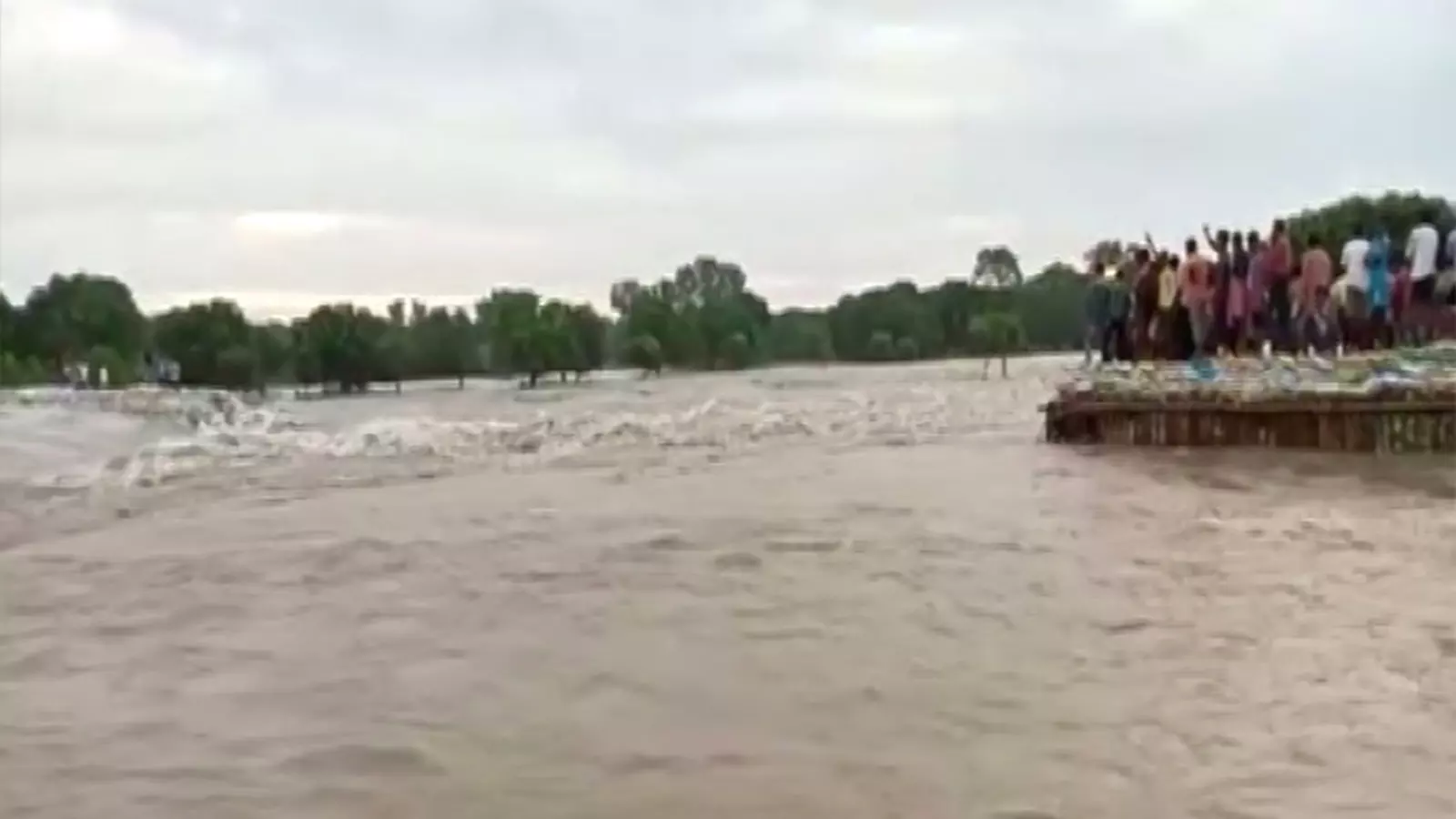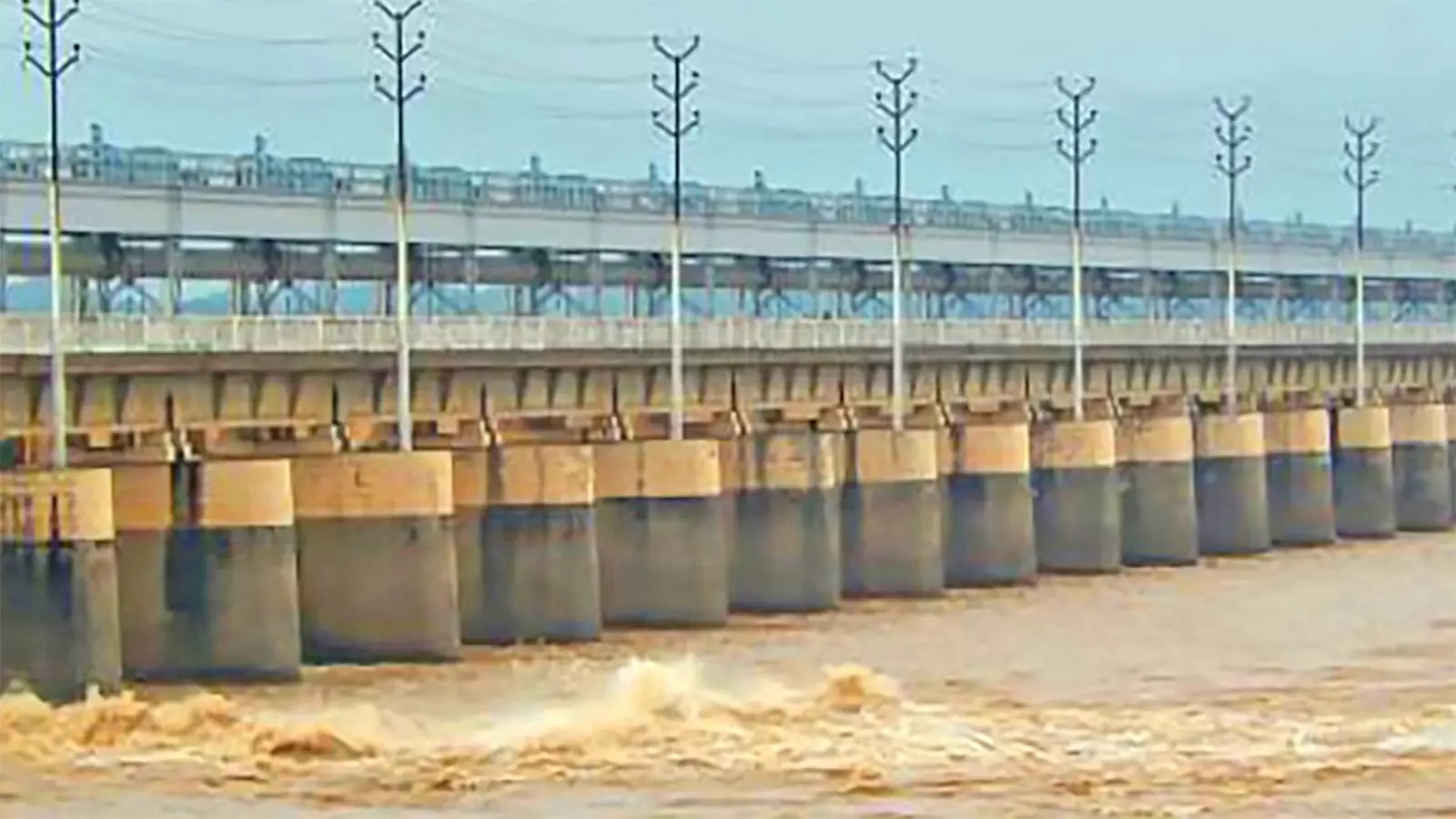
- Home
- India
- World
- Premium
- THE FEDERAL SPECIAL
- Analysis
- States
- Perspective
- Videos
- Sports
- Education
- Entertainment
- Elections
- Features
- Health
- Business
- Series
- In memoriam: Sheikh Mujibur Rahman
- Bishnoi's Men
- NEET TANGLE
- Economy Series
- Earth Day
- Kashmir’s Frozen Turbulence
- India@75
- The legend of Ramjanmabhoomi
- Liberalisation@30
- How to tame a dragon
- Celebrating biodiversity
- Farm Matters
- 50 days of solitude
- Bringing Migrants Home
- Budget 2020
- Jharkhand Votes
- The Federal Investigates
- The Federal Impact
- Vanishing Sand
- Gandhi @ 150
- Andhra Today
- Field report
- Operation Gulmarg
- Pandemic @1 Mn in India
- The Federal Year-End
- The Zero Year
- Science
- Brand studio
- Newsletter
- Elections 2024
- Events
Farakka Barrage: What’s pulling Fulahar and Ganga closer, drowning homes and hopes

The monsoon has just set in. The roiling dark clouds open up with thunderous roars pattering large drops of water on the parched land, wafting petrichor through the air.The musty scent of water soaking the dry soil would lift the spirit of any farmer in anticipation of a bounty. But not for Sailesh Chandra Mandal of Ratua block in West Bengal’s Malda district. The onset of monsoon brings to...
The monsoon has just set in. The roiling dark clouds open up with thunderous roars pattering large drops of water on the parched land, wafting petrichor through the air.
The musty scent of water soaking the dry soil would lift the spirit of any farmer in anticipation of a bounty. But not for Sailesh Chandra Mandal of Ratua block in West Bengal’s Malda district. The onset of monsoon brings to him not the sweet smell of hope, but trepidation of an impending disaster.
River Fulahar flows not very far from his farmland on the eastern banks. The river is gradually changing course towards the east devouring vast swathes of land, displacing hundreds of people every year.

The flooded Fulahar in Malda district of Bengal.
“The intensity of the eastward shift of the river intensifies during monsoon due to westerlies,” Mandal said, explaining his monsoon dread.
More than 300 families, living in the areas vulnerable to erosion in Mahanandatola and Bilaimari gram panchayats of Ratua-I Block, have been shifted to safer areas in the past two weeks. Around 150 houses have been washed away.
Last year, at least ten houses and a temporary police camp in the block were swallowed by the expanding river. “This has been the story of every monsoon for over four decades,” Mandal pointed out.
The Fulahar originates in the Himalayas in Nepal and traverses through Bihar to enter Malda. Meandering about 15 kilometres down south from Ratua, it takes a westward bend to merge with Ganga at Manikchak. All this while the Ganga runs parallel to Fulahar along the district’s western border.
Invoking anxiety for Mandal and thousands of villagers residing along the banks, the rivers are gradually changing their courses eastwards, a phenomenon which has already eroded around 900 square kilometres across the district’s five blocks of Ratua, Manikchak, Kaliachak-1, Kaliachak-2 and Kaliachak-3 since 1971. Around 7 lakh people in the area have been displaced as per an estimate of the Ganga Bhangan Pratirodh Nagarik Action Committee (GBPNAC) and Jana Andolan, the two organisations fighting for the rights of affected people.
“The way the Ganga is shifting towards east, it will soon merge with Fulahar at Ratua. The gap between the two rivers has now dwindled to about a few hundred metres,” West Bengal’s minister of state for irrigation and waterways Sabina Yasmin told The Federal.
“A decade ago, the distance between the two rivers was about 10 kilometres. It has now shrunk to about 800 metres,” said Mosarekul Anwar, a river conservationist who is part of the two grassroots movements.
The confluence will pose an existential crisis to about 75 villages of Ratua block, making nearly another 2.5 lakh people vulnerable.
The changing dynamics of the rivers is overnight reducing landlords to paupers and also creating a new boundary dilemma for the state.
Archana Mandal, an erosion victim from Ratua, said the river has taken away everything—from house to farmland—from her. This is not just her story. “Many have moved homes multiple times in the last 20 years,” Anwar said.
Mohammed Inamul Haque of Panchanandapur of Kaliachak II block is one such victim. He lost 33 acres of land in eight bouts of erosion to the river to now become landless. The district is replete with such stories that led to a surge in the number of slums and increase in marginal and migrant labourers. Malda is among the state’s top three districts in terms of outbound migrant labour.
Bengal ‘flows into’ Jharkhand
The destructive effect of the river’s transformation has given birth to a slice of Bengal in ‘Jharkhand’, creating an identity dilemma for about 2.5 lakh Bengalis.
As the Ganga shifted its course eroding around 900 square kilometres on its eastern bank, some new sand bars (locally called chars) started forming on the western banks near Jharkhand.
“Some 21 mouzas with a cumulative area of 300 square kilometres have been formed since the 1990s on the western banks of the Ganga. These newly formed chars are now home to around 2.5 lakh people, all of whom are those who lost their land due to erosion on the eastern banks of the river,” Anwar said.
The river was the boundary between Bengal and Jharkhand (erstwhile south Bihar) when the state's boundary was defined in 1947. It has now shifted eastward, creating a confusion over the boundary demarcation between the two states.
Many of the newly formed chars have been officially included in its mouza list by the Jharkhand government in 2011. In Jharkhand chars are called diyaras.
“Technically, these chars are part of Malda district of West Bengal. But since the district administration is apathetic in providing basic amenities to the people living in these areas, they naturally turn to the Jharkhand government for help. As a result, this 300 square kilometres of Bengal’s land has for all practical purposes become part of Jharkhand,” Anwar said.
Many residents like Momjad Sheikh are now enrolled as voters in Rajmahal Assembly constituency of the neighbouring state.
“Our land and home in Banutola village on the other side of the Ganga was gobbled up by the river. We moved to this side after the land re-emerged as chars here in the 1990s. We still possess land documents issued by the Bengal government but hold a voter ID card issued by the Jharkhand administration,” he said revealing his dual identity.
The GBPANC has moved the West Bengal government time and again seeking demarcation of the interstate border and immediate extension of all rights and facilities to these “unfortunate people”, said Tarikul Islam, the spokesperson of the committee.
The successive state governments, however, have remained nonchalant to the plight of its displaced residents on either side of the river banks. This has fuelled anger among the victims as was evident when they vented their ire on minister of state for minority affairs and madrasah education Tajmul Hossain recently. The minister was heckled when he visited erosion-affected areas of his constituency, prompting him to hurriedly retreat on a boat.
Clearly, the government needs a quick course correction to deal with the problem, which is aggravating with every passing monsoon.
It’s natural for deltaic rivers to change its path downstream and that leads to a certain amount of erosion. But what is witnessed here is an abnormality.
Impediment in natural course
This deviant behaviour is triggered by the impediment caused to the natural flow of the river due to the construction of 2.62 kilometre-long Farakka barrage in the 1970s. It was constructed between 1962 to 71 and was commissioned in 1975 with a sole aim to transfer 40,000 cusecs water from Ganga to its distributary Hooghly to flush out the sediment deposition that was drying the Kolkata Port. But in reality, the barrage has failed to serve its avowed purpose. Instead, the attempt to impede the natural movement of the river has led to accumulation of more slits on the upstream, raising the riverbed and reducing the velocity of water flow.

Experts say it is the Farakka Barrage which is forcing rivers to change course.
The diminishing velocity in turn leads to formation of curves or meanders that change the river course. Meanders started forming between Rajmahal hills in Jharkhand and Farakka in West Bengal ever since the barrage was constructed.
“The river has widened gradually from 1973 shifting its bank eastward,” pointed out Anwar.
The barrage was a bad idea from the beginning. Kapil Bhattacharya, a river expert and an engineer, objected to its construction, pointing out that it was being built without taking into consideration the flood tides and tide borne silts the river would carry.
He further warned that the barrage would only increase siltation in the river clogging its main drainage channel because in the dry season not much water would be available in the dam to divert towards Hooghly.
He also pointed out that the barrage was designed to discharge too little water in times of deluge, which would lead to flooding of Malda and Murshidabad in West Bengal and several Bihar districts located upstream. Besides, this would also reduce the flow of water to then East Pakistan, now Bangladesh, the engineer cautioned.
Bhattacharya’s warnings were not only ignored, he was also subjected to condemnation and branded as a Pakistani spy.
“The barrage is of no help…. It is to be blamed for the erosion problems of Malda and Murshidabad. The state government has asked the Centre to review the utility of the barrage and if need be, it should be dismantled," Minister Yasmin said.
The state government raised its pitch for the dismantling of the barrage as India and Bangladesh have now decided to review the Farakka Agreement (expires in 2026) on sharing of waters of River Ganga.
“It is high time that the Centre pays some heed to the state’s interest,” she adds.
If that happens, perhaps Mandal will be able to look forward to the monsoon without having to worry about his home and the farmland.
